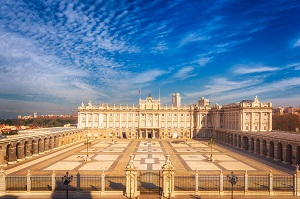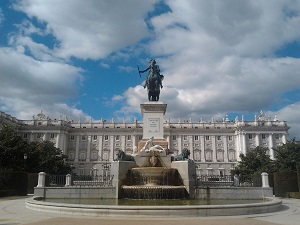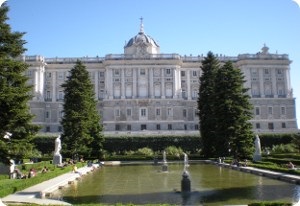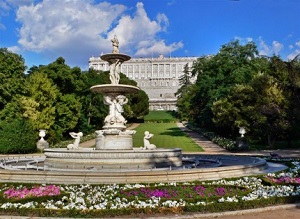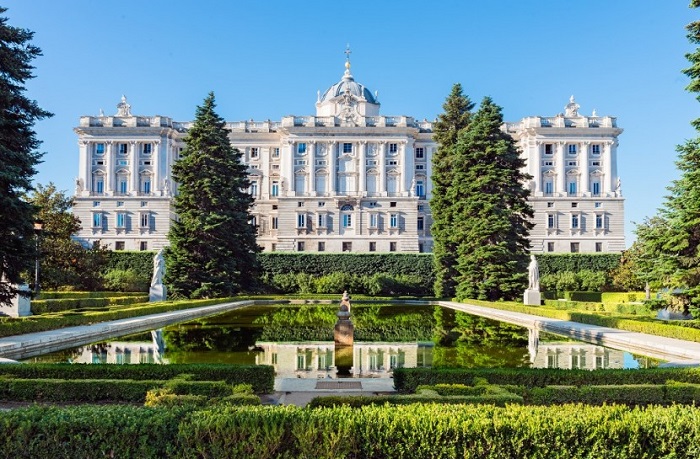
One of the top tourist attractions in the city of Madrid, the Royal Palace is the official residence of the royal family. However, it is only currently used for state ceremonies and it is open to the public for the rest of the time. Also known as the Palacio Royal, it was built during the 18th and 19th centuries and is one of the most monumental buildings in the city. It replaced the former medieval Alcazar which was burnt to the ground in 1974. The Royal Palace in Madrid was decorated according to the taste of Charles III and this is very apparent in the lavish interiors.
In proximity to a number of good hotels, the palace was built on what was once a 9th century fortress. Carlos I has a permanent residence on the site that was burned down in 1734. Felipe V commissioned the palace that stands today on the site. The palace has a whopping 3,418 rooms and just under 1.5 million square feet of floor space, making it Europe's largest based on floor area. The interior of the Royal Palace has priceless arts, watches, frescoes, porcelain and several treasures including the only complete Stradivarius string quintet in the world.
The palace's main staircase has more than 70 steps. Several of the rooms in the palace are open to the public, which are full of furniture and ornate architecture which feature the history of the Spanish people.
Madrid is a beautiful city that is a must-see destination with several tourist attractions, the Royal Palace included. Fortunately, there are plenty of options for people who would like to explore the city, including Madrid day trips, and Madrid walking tours. Travelers on a tight budget will be happy to know that there are plenty of free things to do in Madrid.
Traveling, especially with a limited budget can be a challenge, especially because there are various tours and combos available in the market. Looking through all of them requires time and effort but you need not worry anymore. We have done the hard work and checked everything that is being offered and we have picked a selected few which will give you value for your money.
The below table includes a brief description of various handpicked Royal Palace Madrid tickets & skip the line guided tours of the Royal Palace Madrid. They're based on users reviews, cost, customer experience as well as all the best ways to see the famous Royal Palace Madrid sight. We've compared prices from a variety of skip the line Royal Palace Madrid guided tours & tickets, websites and have handpicked the most affordable Royal Palace Madrid combination tickets, but utterly enjoyable Royal Palace Madrid tours & tickets below:







Just seeing the exteriors of the Royal Palace is already impressive enough but there is also so much to see inside that it is an opportunity that you should not miss. The elegant iron fencing conceals a vast courtyard, and to the side of the courtyard is a stunning view of the countryside beyond. Come on a clear day and you will see a breathtakingly panoramic view.
The Royal Palace housed the kings and queens of Spain from the mid 1700s to the 1900s. Although it is no longer the residence of the Royal Family now, it is still considered as so. You can expect to be wowed by the luxuriousness and the grandeur of the palace. However, the long lines is something which people constantly complain about. So, the best thing you can do is go there early, or better yet, get skip-the-line tickets.
Once you are inside the Royal Palace, you have the option of purchasing either a ticket for a guided tour, or a regular ticket which allows you to walk at your own pace. The guided tour is ideal for those who would like an in-depth lesson about the palace which takes almost an hour. If you decide to get the regular ticket, there are information points throughout which explain more about the rooms and their different functions.
Getting a regular ticket gives you access to lavish halls, residential areas, the throne room, banquet rooms, the Royal Armoury, and the Royal Pharmacy. Several significant events have taken place in the palace including the signing of the treaty of Spain which granted them acceptance into the European Union in 1985. There are also art exhibits which are available for viewing at no extra charge.
The Royal Palace in Madrid is a 5-minute walk from the Opera metro station. From the Airport, take Line 8 to Nuevos Ministerios and then change to line 10 and get off Plaza de Espana station. You will see the Royal Palace after 5 minutes.
Alternatively, people coming from the centre, around the Plaza Mayor, can follow Calle Mayor directly to the palace and you they will find themselves at its doors in less than fifteen minutes.
Calle de Bailen, s/n 28071 Madrid, Spain
Filippo Juvarra was the architect who took inspiration from Gian Lorenzo Bernini, as well as French Baroque palaces. He died in 1736 and architect Giambattista Sacchetti took the over the reins of the design process. Francesco Sabatini was summoned to expand the building in 1760.
| Grand Staircase | Royal Library | Royal Armory |
| About | ||
| Built by Sabatini in 1789 and moved from where it was originally place in 1760. It is composed of a single San Agustin marble. | Moved to the lower floor during the reign of Maria Christina with bookshelves dating to the period of Charles III. | Considered as one of the best in the world, next to the Imperial Armoury of Vienna. It consists of pieces from the early 13th century. The building was designed by E. Repulles and J.S. de Lema and was opened to the public in 1897. |
| Best views | ||
| Being on the top landing gives a sweeping view of the ground floor | Check the book covers which demonstrate the evolution of binding styles through various eras. Some great examples are the Rococo in gold with iron lace, as well as the Renaissance and Gothic motifs. | Look out for the shield and burgonet made by Francesco and Filippo Negrolli, one of the most famous designers in the armourer's guild during that time. |
| Things to do | ||
| Watch out for and take a photo of the two lions gracing the landing, as well as the ceiling frescoes depicting Religion Protected by Spain made by Corrado Guiaquinto. | Be on the lookout for library highlights such as the Book of Hours of Isabella of Castile, a codex of the time of Alfonso XI of Castile and a bible of Doṅa Maria de Molina and a selection of medals from the Royal Collection. | Check the highlights of the royal collection which include pieces made for Charles V and Philip II by the leading armourers of Augusburg and Milan. Some of the most remarkable works are full armours and weapons that Emperor Charles V used in the Battle of Muhlberg. |
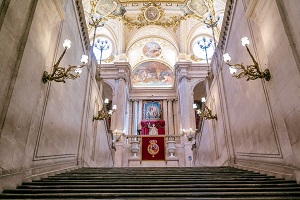
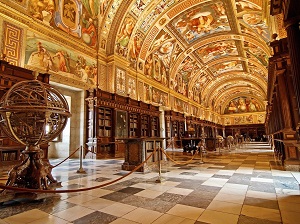
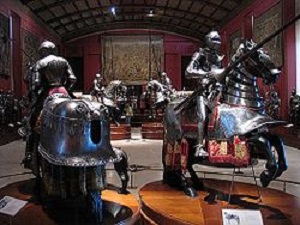
| King Charles III's Apartments | The Queen's Apartments | Apartments of Infante Luis | Royal Chapel | The Crown Room |
| About | ||||
| Also known as the Conversation Room, the apartment has various important frescoes and sis spread over various sections. | Formerly the queen's apartments during the reign of Charles III, the apartment has three different rooms which were converted into a banquet hall by Alfonso XII in 1879. | These rooms were formerly occupied by Infante Luis, the Count of Chinchon before he was exiled. | Once the main chapel of the royal family, it is now used only occasionally, most notably for funerals. The funerals for both the Count and Countess of Barcelona were held in the chapel in 1993 and 2000 respectively. | Formerly used by Maria Christina of Austria, the mother of Alfonso XIII. It was established following the accession King Felipe VI in 2014 to display the symbols of constitutional monarchy. |
| Best views | ||||
| See the Throne Room, Hall of Columns, and Guard Room. | Some of the magnificent works or art made by Alejandro Gonzalez, Francisco Bayeu y Subias, and Raphael Mengs. | The ceiling frescoe by A.G. Velasquez is something to behold, as well as the Musical Instruments Room. | The reliquary altar has Ercole Ferrata's 1659 silver relief called Pope Leo I Stopping Attila at the Gates of Rome. | Look out for the original throne of King Carlos III, as well as his crown and sceptre. There is also the collar of the Order of the Golden Fleece belonging to Queen Isabella II, and the Tale of Sphinxes. |
| Things to do | ||||
| Check out the ceiling frescoes done made by A.R. Mengs. | Look out for the three ceiling frescoes | Do not forget to find the Stradivarius Room with two violins made by Stradivari, a viola and two violincellos. | Check out the frescoes made by Giaquinto including The Holy Trinity Crowning the Virgin. | One of the highlights is the majestic Empire style desk acquired by King Carlos IV in 1803 where King Carlos signed the Organic Act, confirming his abdication from the throne. |
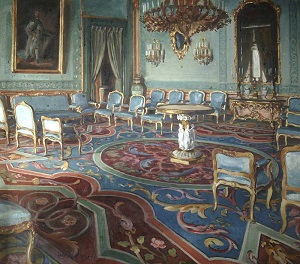
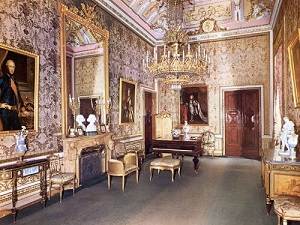
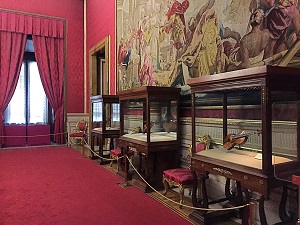
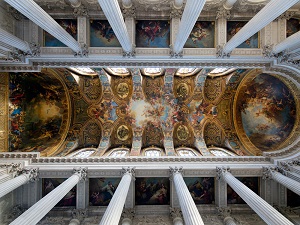
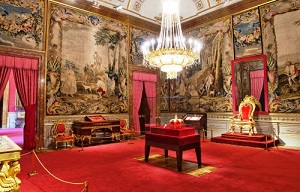
| Plaza de la Armeria | Plaza de Oriente | Campo del Moro Gardens | Sabatini Gardens |
| About | |||
| The square was laid out in 1892, according to the plan made by architect Enrique Maria Repulles. | A rectangular park that connects the eastern side of Palacio Real to the Teatro Real. The plaza's eastern side is curved and is bordered by several cafes in the adjoining buildings. | The gardens are named after the Muslim leader Ali Ben Yusuf, who was thought to camp in the gardens with his troops in 1109 during a siege. | The Sabatini Gardens is located on the north side of the palace and extends to the Calle de Bailen and the cuesta de San Vicente. |
| Best views | |||
| Get amazing views of the Palace from the plaza. | From Plaza de Oriente, you will get amazing views of the Central Gardens, the Lepanto Gardens, and the Cabo Noval Gardens. | The park is designed in the romanticist style and has several fountains. | The garden has a symmetrical French design and feature a large rectangular pond surrounded by four fountains and statues of Spanish kings. |
| Things to do | |||
| The Almudena Cathedral faces the palace from across the plaza and it has a neoclassical exterior to match the surroundings while the interior is neo-gothic in design. | The annual flowers are something to behold, and the magnolias, yew, and small cypress consist some of the seven flower beds. | Take a beautiful photo by the fountains and the Large Cavern Grotto built by Juan de Villanueva. | Explore the gardens that was only opened to the public in 1978 under King Juan Carlos. |
